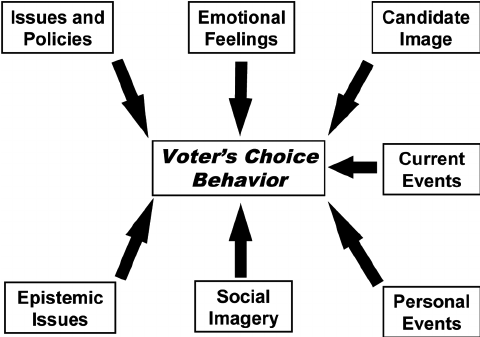Ever had a spat with someone in your own crew?
You know, like your friend who insists on ordering a martini at a brewery or who askes for a seperate bill at a group meal?
That same type of disagreement happens in politics—and it’s not always between Democrats and Republicans.
Sometimes, the real animosity brews within a single party.
With the recent ousting of Liz Cheney and her subsequent campainging with VP Harris, I wanted to So, let’s dig into some academic research and see why people might sometimes like their in-party rivals even less than the other side.
The research is scarce, but I did fine one paper.

Title: Affective Polarization Within Parties: When Partisan Rivals Dislike Each Other More Than the Opposition
Link: Affective Polarization Within Parties (2024)
Peer Review Status: Peer Reviewed
Citation (APSA format):
Young, David J. and Lee H. de-Wit. 2024. “Affective Polarization Within Parties.” Political Psychology. https://doi.org/10.1111/pops.12973.
Introduction
Affective polarization—where we like our political tribe and dislike the opposing one—has been on the rise.
But unsurpingly: polarization doesn’t stop at the party line. Young and de-Wit (2024) dive into how this dislike festers within parties themselves.
In this paper, they focused on the U.S. and the U.K. to investigate if political factions within parties (think progressive vs. centrist Democrats or pro- and anti-Brexit Conservatives) can stir up as much, or more, animosity than traditional partisan battles.
Methodology
This paper contains the results of two studies: One conducted using data from Great Britian, the second a stand alone study conducted within the US.
Study 1 (Great Britain)
Young and de-Wit began by examining within-party polarization in the U.K. They embedded questions into two waves of an ongoing longitudinal study into polarization
in Great Britain (The MHP Polarization Tracker).
They surveyed British participants who identified with the Labour or Conservative parties. Participants were asked to rate how much they liked factions within their own party (e.g., Labour’s pro-Corbyn vs. pro-Starmer supporters) and factions from the opposing party. In addition, participants provided ratings on traits like kindness and intelligence, and their comfort with having a member of these factions as a friend.
The study involved two waves of data collection: one in February 2022 and another in July 2022. The final sample included over 900 participants in each wave, with analyses focusing on paired-sample t-tests to compare within-party factionalism against between-party polarization.
Study 2 (United States)
In the U.S. study, the researchers employed a similar methodology but with a focus on American political factions. They surveyed 443 participants, using Prolific, with Republicans and Democrats rating how they felt toward factions within their own party and in the opposing party. The U.S. factions included, for example, Trump-supporting Republicans versus Cheney-supporting Republicans and Biden-supporting Democrats versus AOC-supporting Democrats.
This study introduced a new dimension: participants were also asked how likely they would be to vote for their party’s presidential candidate if that candidate was from their opposing faction.
Both studies highlighted how factional identities can sometimes eclipse party identities, leading to stronger negative feelings toward in-party rivals than toward members of opposing parties.
Results and Findings
The study found that within-party polarization is substantial, sometimes rivaling or even exceeding between-party polarization.
In both the U.K. and U.S., participants frequently showed a strong preference for their own faction within the party over rival factions.
“While within-party affective polarization tends to be weaker than between-party,
it can be just as strong or even stronger in some cases—six of the 14 factions showed a preference for themselves over their in-party rival faction that had an effect at least
as large as a between-party effect in their country” (p. 16)
In Study 1 (Great Britain), participants exhibited significant within-party polarization, particularly among Labour factions. The findings showed that Labour’s factions had higher affective polarization than Conservative factions. For instance, participants who preferred Corbyn rated their faction much more positively than rival factions supporting Starmer, with effect sizes in the moderate-to-large range (p. 9) This division was significant enough that many participants preferred an out-party faction, like Brexit-supporting Conservatives, over their in-party rivals (p. 9).
Study 2 (United States) showed similar results. Trump-supporting Republicans had higher levels of affective polarization toward rival factions within their own party, such as those supporting Liz Cheney, compared to Democrats (p. 13). Interestingly, within-party polarization was strongest among Republicans, particularly on controversial issues like Trump’s leadership and the 2020 election results (p. 14).
In both studies, there were instances where participants expressed a preference for an out-party faction over their in-party rivals. This was particularly noticeable among Labour supporters in the U.K. and pro-Trump Republicans in the U.S., where the animosity toward in-party rivals exceeded that toward members of the opposing party (p. 9 and p. 15).
These findings challenge the notion that political divisions are primarily between parties and suggest that factional disputes within parties can drive as much or more polarization than traditional partisan divides.
Critiques and Areas for Future Study
While this study provides fascinating insights, there are a few limitations. For one, the factions studied were selected based on current high-profile disagreements, which might not capture long-term trends in party divisions. Additionally, while the study focused on significant factional disputes, it’s possible that future research could benefit from examining smaller, less obvious factions to get a fuller picture of within-party polarization. Asking what does a faction let slide versus go to war over? Another point for future exploration? Investigating how factional identity impacts not just feelings of animosity but actual voting behavior. While the authors performed some additional analysis finding:
“No faction was more likely to vote for an out-party candidate than the candidate from the rival factional , though the Cheney faction
was no more likely to vote for Trump than either Biden, “(p. 17) this area remains ripe for additional study.
What are the factors that lead to cross over voting and party switches? Are they push or pull factors?
Could factional splits within a party eventually lead to new parties or movements altogether? Realignments?
This research just scratches the surface of that possibility, but is does add some knowledge to a topic derth of research.
While the authors performed some additional analysis finding:
“No faction was more likely to vote for an out-party candidate than the candidate from the rival factional , though the Cheney faction
was no more likely to vote for Trump than either Biden, “(p. 17) this area remains ripe for additional study.
What are the factors that lead to cross over voting and party switches? Are they push or pull factors?
Could factional splits within a party eventually lead to new parties or movements altogether? Realignments?
This research just scratches the surface of that possibility, but is does add some knowledge to a topic derth of research.Conclusion
Young and de-Wit’s research shines a light on an often-overlooked aspect of political polarization: the battles within.
Whether it’s Labour centrists and progressives at odds or Republicans fighting over the legacy of Donald Trump, it’s clear that some of the most heated disputes aren’t always across party lines.
So next time your uncle rails against his party’s nominee, remember—sometimes the fiercest political fights happen inside the family.

